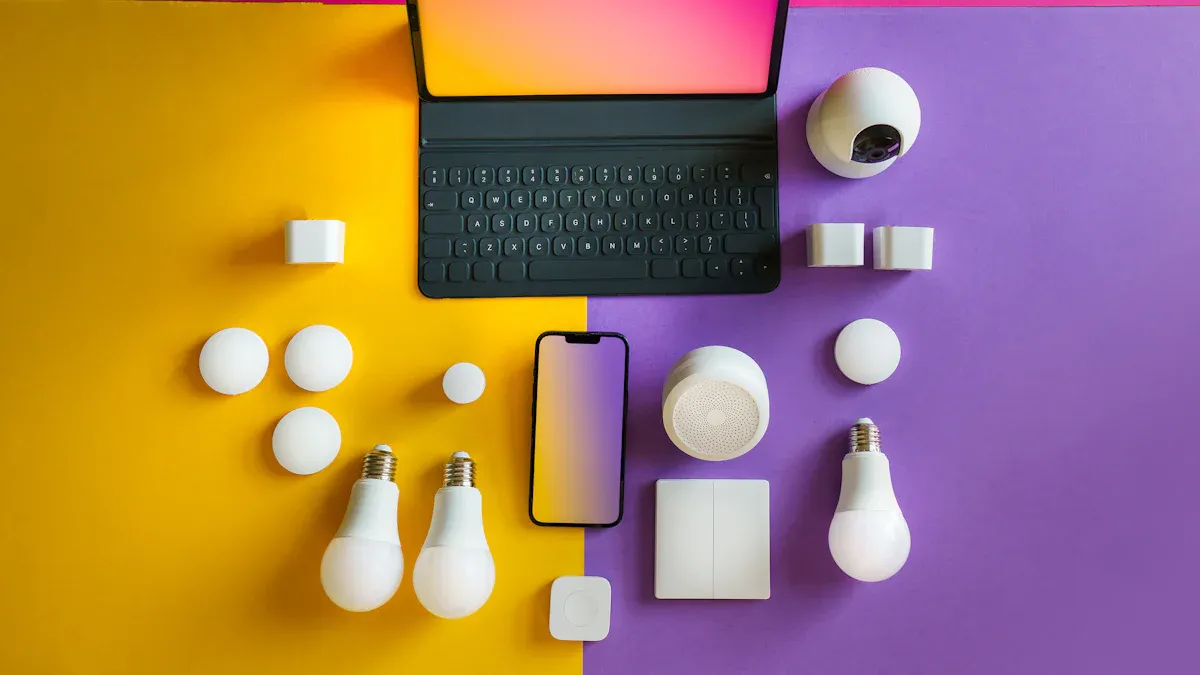How to clean and polish your Helius flashlight lens without scratching it

Keeping your Helius flashlight lens clean ensures optimal performance and crystal-clear illumination. Dirt and smudges can reduce clarity, affecting its functionality. By following proper cleaning techniques, you can avoid scratches and maintain the lens's quality. Regular care not only extends the lens's lifespan but also enhances the flashlight's overall efficiency.
Key Takeaways
Clean your flashlight lens with a microfiber cloth and safe cleaner. This stops scratches and keeps it clear.
Check your lens often for dirt or damage. Fixing problems early keeps it working well.
Keep your flashlight in a case when not using it. This avoids scratches and makes the lens last longer.
Preparation for Cleaning
Gather essential materials like a microfiber cloth and lens-safe cleaning solution
Before you start cleaning your Helius flashlight lens, gather the right materials to ensure a scratch-free process. A microfiber cloth works best for wiping down the lens. Its soft fibers prevent scratches and effectively remove dust. For more delicate cleaning, you can use a suede or silk cloth. These materials are gentle on optical surfaces and help maintain clarity. If you need to tackle oily residues or stubborn smudges, a lens-safe cleaning solution or distilled water will do the job. Avoid using paper towels or tissues, as they can leave fibers or cause scratches.
Set up a clean, dust-free workspace to avoid contamination
Choose a workspace that is free from dust and debris. A clean environment prevents particles from settling on the lens during cleaning. You can use a soft mat or towel to create a stable surface for your flashlight. Ensure the area has good lighting so you can clearly see the lens and any dirt or smudges. Keeping your workspace organized also helps you avoid accidental scratches caused by misplaced tools or materials.
Inspect the Helius flashlight lens for dirt, smudges, or existing scratches
Take a close look at the lens before you begin cleaning. Check for visible dirt, smudges, or fingerprints. Use a flashlight or natural light to spot any imperfections. If you notice scratches, proceed with extra care to avoid worsening the damage. Identifying the condition of the lens helps you decide how much cleaning is needed and which materials to use. This step ensures you achieve the best results while maintaining the lens's clarity.
Cleaning the Helius Flashlight Lens

Use a soft microfiber cloth to remove loose dust and debris
Start by using a microfiber cloth to gently remove any loose dust or debris from the lens. This type of cloth is ideal for cleaning lenses because it effectively eliminates dirt and smudges without causing scratches. Unlike tissues or paper towels, microfiber cloths do not leave behind fibers or trap dirt particles that could damage the surface. They are also reusable and durable, making them an eco-friendly choice. For light cleaning, you may not even need additional cleaning solutions—just the cloth itself can often do the job.
Tip: Always ensure the microfiber cloth is clean before using it. A dirty cloth can transfer particles onto the lens, increasing the risk of scratches.
Apply a lens-safe cleaning solution or distilled water for stubborn stains
If you encounter stubborn smudges or oily residues, apply a lens-safe cleaning solution or distilled water. Avoid using household glass cleaners like Windex, as they can damage the lens coating. Instead, opt for eyeglass sprays or a mild soap and water mixture. Lightly moisten the microfiber cloth with the solution rather than spraying it directly onto the lens. This method ensures better control and prevents excess liquid from seeping into the flashlight's internal components.
Gently clean the lens in circular motions to avoid scratches
When cleaning the lens, use gentle circular motions with the microfiber cloth. This technique helps distribute pressure evenly and reduces the risk of scratches. Avoid using your shirt sleeve, tissues, or any rough material, as these can cause micro-scratches that diminish the lens's clarity over time. Take your time and focus on one section of the lens at a time to ensure thorough cleaning. Once finished, inspect the lens under good lighting to confirm it is free of smudges and dirt.
Note: Regular cleaning not only restores the lens's clarity but also enhances the performance of your Helius flashlight.
Polishing the Helius Flashlight Lens

Select a non-abrasive polishing compound suitable for optical surfaces
To restore the clarity of your Helius flashlight lens, choose a non-abrasive polishing compound designed for optical surfaces. Products like Plastix or Meguiars Headlight Wax work well for this purpose. These compounds remove fine scratches and enhance the lens's shine without causing damage. Avoid abrasive materials, as they can worsen existing imperfections. If your lens has heavy discoloration or stubborn marks, consider starting with a mild abrasive like toothpaste before moving on to a polishing compound. This step ensures the lens regains its smooth and clear surface.
Tip: Always test the polishing compound on a small, inconspicuous area of the lens before applying it fully.
Use a soft applicator or polishing pad for even application
For even application, use a soft applicator or a foam polishing pad. These tools distribute the compound evenly across the lens, preventing streaks or uneven polishing. Begin by washing the lens with a gentle soap like Dawn and water to remove any residue. If the lens has significant discoloration, you can use a Trizact pad to prepare the surface. Apply a small amount of the polishing compound to the pad and spread it in a thin layer over the lens. This method ensures consistent coverage and avoids over-polishing any single area.
Buff the lens gently to restore its clarity and shine
Once the compound is applied, buff the lens gently using circular motions. A white terry shop towel or foam pad works best for this step. Apply light pressure to avoid scratching the surface. If you’re using toothpaste as a polishing agent, rinse the lens with water after buffing to remove any residue. For a final touch, use Plastix or a similar product to achieve a high-gloss finish. Wipe off any excess compound with a clean towel, and inspect the lens under good lighting to ensure it looks clear and polished.
Note: Adding a protective layer, such as Meguiars Headlight Wax, can help maintain the lens's clarity and protect it from future damage.
Preventing Scratches During Cleaning
Avoid abrasive materials like steel wool or rough sponges
Using abrasive materials like steel wool or rough sponges can cause permanent damage to your flashlight lens. These materials create micro-scratches that reduce clarity and make it harder to remove scratches later. Instead, always choose soft, non-abrasive tools like microfiber cloths or foam pads. These options are gentle on the lens and help improve lens clarity without risking damage. If you need to clean stubborn dirt, rely on lens-safe cleaning solutions rather than scrubbing with harsh materials.
Tip: Always inspect your cleaning tools before use. Even a small particle trapped in a cloth can scratch the lens.
Store the flashlight in a protective case when not in use
Proper storage is essential for preventing scratches. When you’re not using your Helius flashlight, keep it in a protective case. This shields the lens from dust, dirt, and accidental impacts. A case with a soft lining offers extra protection, ensuring the lens remains scratch-free. Avoid placing the flashlight in pockets or bags without protection, as keys, coins, or other objects can scratch the surface. Consistent use of a case helps maintain the lens’s clarity and reduces the need to remove scratches frequently.
Regularly clean the lens to prevent dirt buildup that could cause scratches
Regular cleaning is crucial for maintaining your flashlight’s performance and clarity. Dirt and debris left on the lens can act like sandpaper, causing scratches over time. To prevent this, clean your flashlight every six months. Use a microfiber cloth or a lens cleaning solution designed for optics to achieve a streak-free finish. Pay special attention to the lens, ensuring it remains free from dust, dirt, and fingerprints. Regular maintenance not only improves lens clarity but also reduces the risk of needing to remove scratches later.
Reminder: A clean lens ensures your flashlight delivers optimal performance and extends its lifespan.
Maintenance Tips for Long-Term Care
Inspect the lens periodically for signs of damage or wear
Regular inspections help you catch potential issues early. Examine the lens under good lighting to spot scratches, smudges, or discoloration. Look for signs of wear that might affect its performance, such as reduced clarity or uneven surfaces. If you notice any damage, address it promptly to prevent further deterioration. Keeping an eye on the lens ensures it stays in optimal condition and performs as expected.
Tip: Use a magnifying glass to detect fine scratches or imperfections that are hard to see with the naked eye.
Use a lens cap or cover to protect the lens when not in use
A lens cap or cover acts as a shield, protecting your flashlight lens from harm. It prevents dust, moisture, and fingerprints from accumulating on the surface. It also reduces the risk of scratches caused by accidental contact with hard objects. Using a cover is an affordable way to safeguard your lens and extend its lifespan.
Benefits of a lens cap or cover:
Acts as a barrier against environmental elements.
Provides cost-effective protection for long-term care.
Make it a habit to cover the lens whenever the flashlight is not in use. This simple step can save you time and effort in cleaning and maintenance.
Replace the lens if scratches become severe and affect performance
Sometimes, scratches can become too severe to fix. If cleaning and polishing no longer restore clarity, replacing the lens is the best option. A damaged lens can reduce the flashlight's brightness and compromise its functionality. Replacing it ensures your flashlight continues to perform at its best. Check with the manufacturer or authorized dealers for compatible replacement lenses. Investing in a new lens keeps your flashlight reliable and efficient.
Reminder: Always handle the replacement lens with care to avoid scratching it during installation.
Caring for your Helius flashlight lens ensures it stays in excellent condition. Regular cleaning with a microfiber cloth and lens-safe solution keeps the lens free from dust and fingerprints. Routine maintenance protects your investment and extends the flashlight's lifespan. By following these steps, you maintain clarity and enjoy reliable performance for years.
Tip: Store your flashlight properly and inspect it periodically to prevent damage and ensure optimal functionality.
FAQ
How often should you clean your Helius flashlight lens?
You should clean the lens every six months or whenever it appears dirty. Regular cleaning prevents dirt buildup and ensures optimal performance.
Tip: Inspect the lens periodically to determine if cleaning is needed sooner.
Can you use household glass cleaners on the lens?
No, avoid household glass cleaners like Windex. These can damage the lens coating. Use a lens-safe cleaning solution or distilled water instead.
Reminder: Always check the product label to ensure it’s safe for optical surfaces.
What should you do if the lens gets scratched?
If scratches are minor, use a non-abrasive polishing compound to restore clarity. For severe scratches, replace the lens to maintain flashlight performance.
Note: Handle the lens carefully during cleaning to prevent new scratches.
See Also
A Comprehensive Approach to Flashlight Cleaning Techniques
In-Depth Review of the Heliusworld Flashlight Model
Complete Manual for Maintaining and Cleaning Your Flashlight
